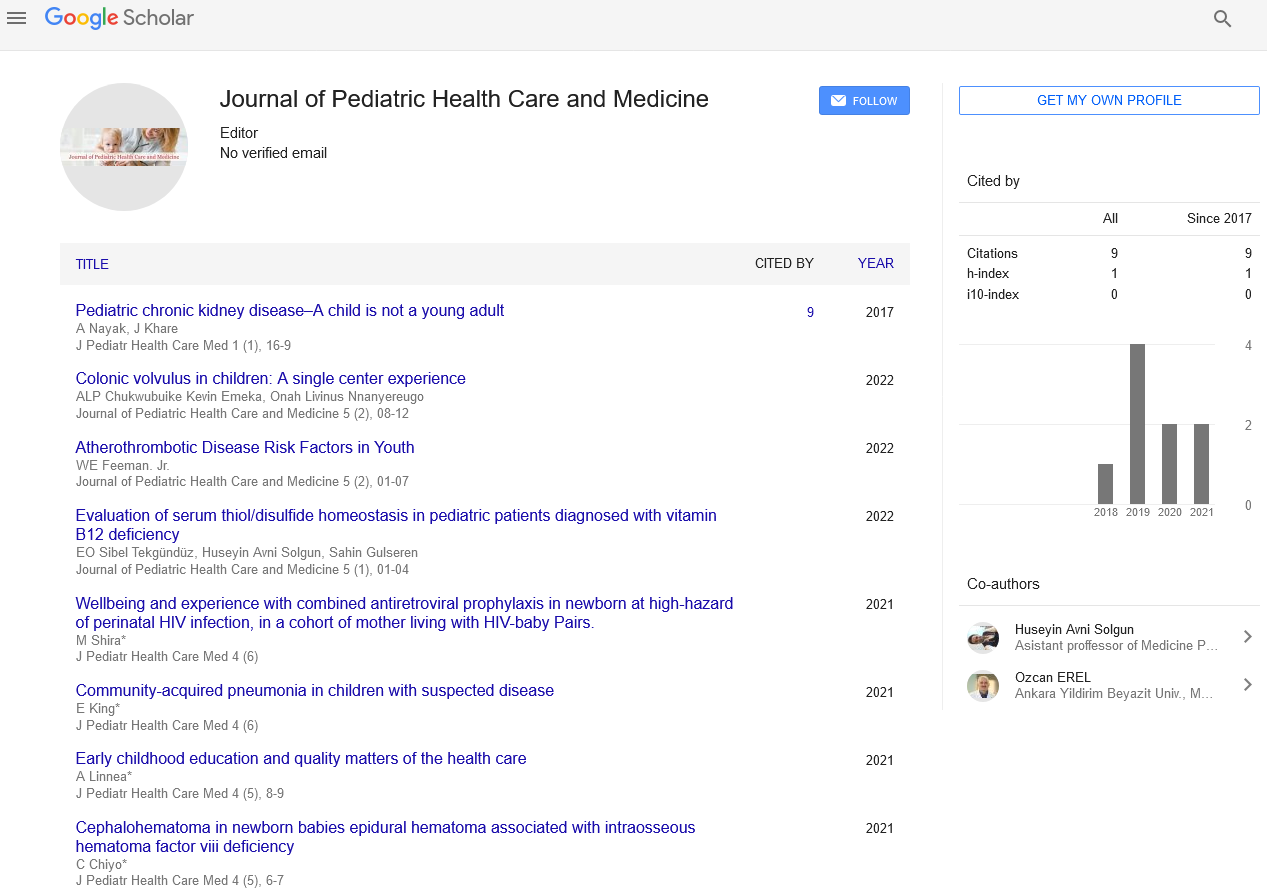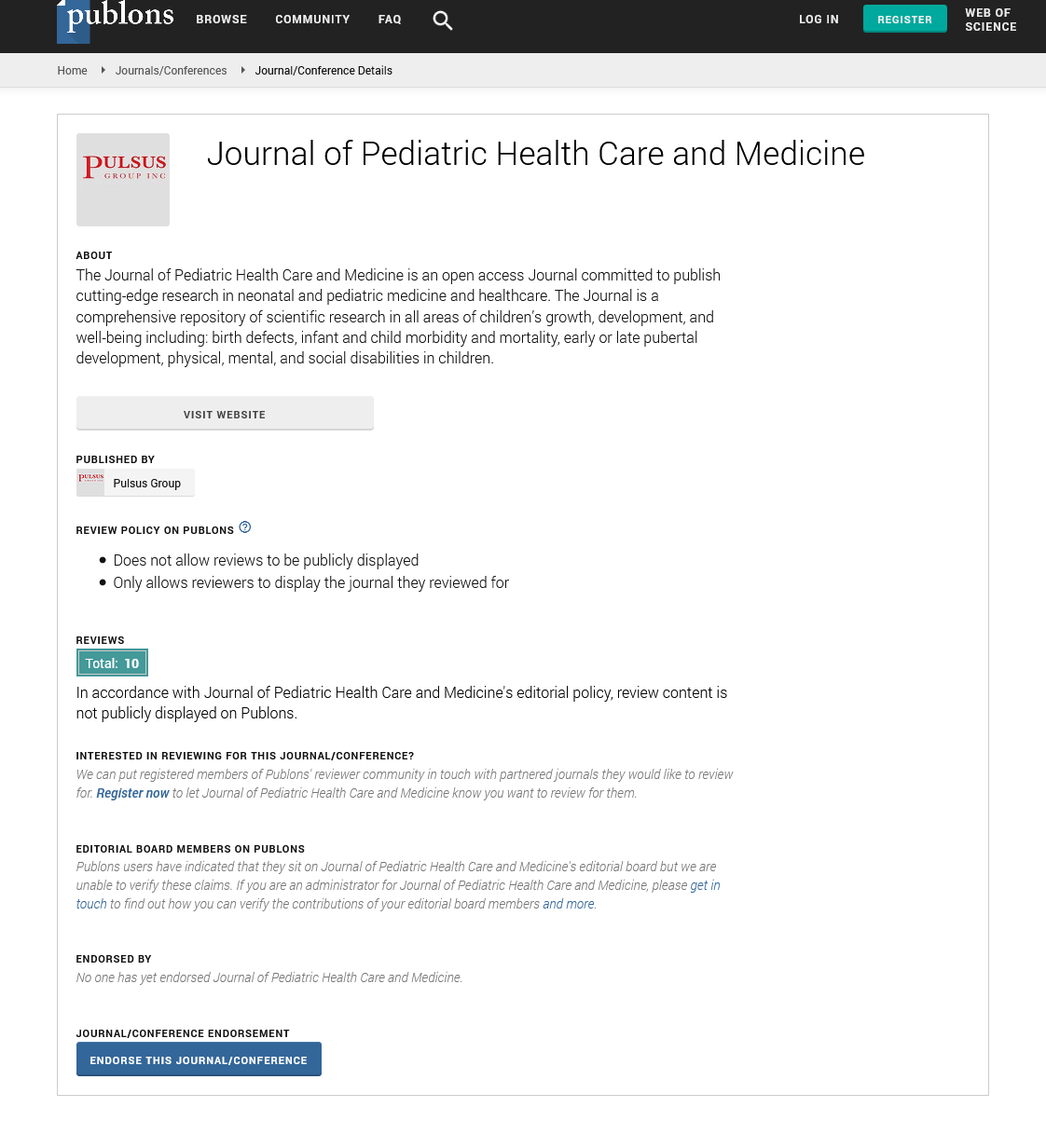Wellbeing and experience with combined antiretroviral prophylaxis in newborn at high-hazard of perinatal HIV infection, in a cohort of mother living with HIV-baby Pairs.
Received: 15-Nov-2021 Accepted Date: Nov 30, 2021; Published: 06-Dec-2021
Citation: Malia Shira. Wellbeing and experience with combined antiretroviral prophylaxis in newborn at high-hazard of perinatal HIV infection, in a cohort of mother living with HIV-baby Pairs. J Pediatr Health Care Med. 2021; 4(6): 17.
This open-access article is distributed under the terms of the Creative Commons Attribution Non-Commercial License (CC BY-NC) (http://creativecommons.org/licenses/by-nc/4.0/), which permits reuse, distribution and reproduction of the article, provided that the original work is properly cited and the reuse is restricted to noncommercial purposes. For commercial reuse, contact reprints@pulsus.com
Abstract
Perinatal transmission of HIV has significantly diminished in big league salary nations over the most recent couple of years with current rates underneath 1%, yet it actually happens in high-hazard circumstances, primarily pregnant ladies with late determination of disease, poor antiretroviral adherence and a high popular burden (VL). In these high-hazard circumstances, numerous suppliers suggest consolidated neonatal prophylaxis (CNP). Our point was to assess the wellbeing and poisonousness of CNP in babies considered at high-hazard of HIV disease among mother-newborn child sets in the Madrid Cohort.
Keywords
HIV; Transmission; Postexposure
Introduction
The Perinatal HIV transmission has drastically diminished in big time salary nations, with current rates beneath 1%. This decrease is because of the execution of compelling preventive measures, incorporating widespread HIV separating pregnancy, early execution of antiretroviral treatment (ART) and organization of postexposure newborn child prophylaxis (PEP) [1]. 24 Nevertheless, perinatal transmission actually happens, predominantly on account of botched freedoms for avoidance. The decision of antiretroviral prophylaxis routine in infants is controlled by the evaluated hazard of perinatal transmission. In high-hazard circumstances, especially babies whose moms had late determination or poor viral control, most rules suggest blend neonatal prophylaxis (CNP), in view of the organization of at least two antiretroviral drugs. As indicated by European Pregnancy and Pediatric Cohort Collaboration (EPPICC) information [2].
Statistical Analysis
An impromptu data set was made utilizing Microsoft Access (Microsoft Corporation, Redmond, WA). Information were handled and broke down utilizing the measurable bundle SPSS v.21.0 [3].
Subjective factors were summed up by their recurrence appropriation. Quantitative factors were introduced as means and standard deviations (SD). The consistent non-ordinarily appropriated factors were summed up by the middle and interquartile range. Like different examinations, we noticed an expansion in the utilization of CNP over time. The traveler populace has expanded in Spain as of late. In our companion, most ladies whose babies got CNP were unfamiliar conceived, as opposed to moms of kids treated with AZT alone, who were primarily Spanish conceived. In any case, the Spanish financial emergency may have added to a slight drop in the appearance of transients as of late bringing about a lower extent of pregnancies with poor antenatal control [4].
Conclusion
Our discoveries support the wellbeing and bearableness of CNP in big league salary nations for babies at high-hazard of HIV-1 perinatal transmission, albeit more investigations are justified for preterm newborn children. The transmission rate in high-hazard circumstances in kids getting CNP in our accomplice is by all accounts lower than that announced already in nonbreasttaking care of, high-hazard newborn children getting AZT monotherapy in industrialized nations. In spite of the fact that our patient populace isn’t practically identical, the general transmission rate in our accomplice seems not to be distinctive to the arms getting CNP in an enormous randomized clinical preliminary of babies brought into the world to moms without ART during pregnancy10 or from huge observational partner studies in Europe.
REFERENCES
- Townsend CL, Cortina-Borja M, Peckham CS, et al. Low rates of mother-to-child transmission of HIV following effective pregnancy interventions in the United Kingdom and Ireland, 2000-2006. AIDS. 2008;22:973–981.
- European Pregnancy and Paediatric HIV Cohort Collaboration (EPPICC) study group in EuroCoord. Severe haematologic toxicity is rare in high risk HIV-exposed infants receiving combination neonatal prophylaxis. HIV Med. 2019;20:291–307.
- Connor EM, Sperling RS, Gelber R, et al. Reduction of maternal-infant transmission of human immunodeficiency virus type 1 with zidovudine treatment. Pediatric AIDS Clinical Trials Group Protocol 076 Study Group. N Engl J Med. 1994;331:1173–1180.
- Wade NA, Birkhead GS, Warren BL, et al. Abbreviated regimens of zidovudine prophylaxis and perinatal transmission of the human immunodeficiency virus. N Engl J Med. 1998;339:1409–1414.






